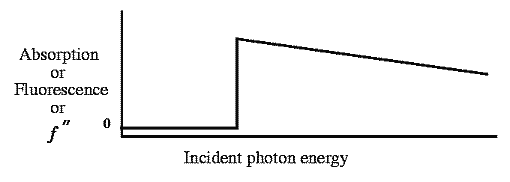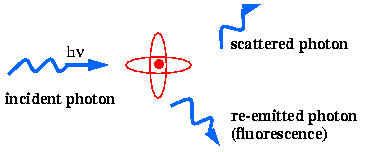
The classical derivation of the physical basis for anomalous scattering is developed by treating the scattering interaction as a pair of coupled oscillators. One oscillator is the e component incident x-ray wave; the other is an electron of the scattering atom treated as a dipole oscillator with frequency equal to the observed value of an absorption edge. This treatment is expounded at length by James (1948). A more compact presentation is given by this IUCr teaching pamphlet.
Unfortunately, the classical approach does not lend itself to an intuitive summary. I will therefore instead try to give a basic description in terms of the scattering cross section of an atom as seen by an incident x-ray photon.
![[picture of photon being scattered by atom]](as_1a.gif)
![[cartoon of energy levels]](as_1b.gif)

This effect is most easily measured as a function of x-ray energy by noting either the sharp increase in absorption or in fluorescence (see figure below). The imaginary scattering component f" is proportional to these directly measurable quantities. The real scattering component f' is related to f" via the Kramers-Kronig relationship.

 X-ray Anomalous Scattering
X-ray Anomalous Scattering
 Breaking Friedel's Law
Breaking Friedel's Law